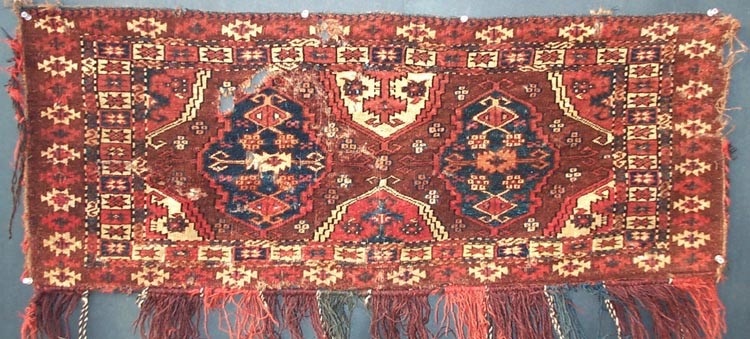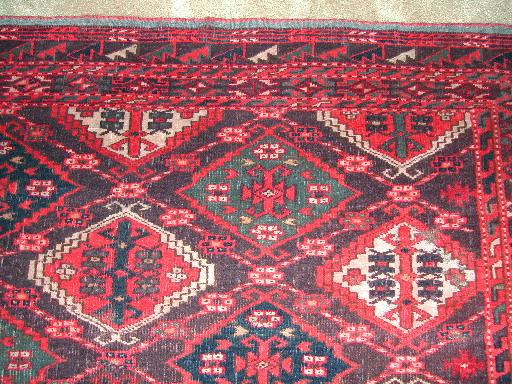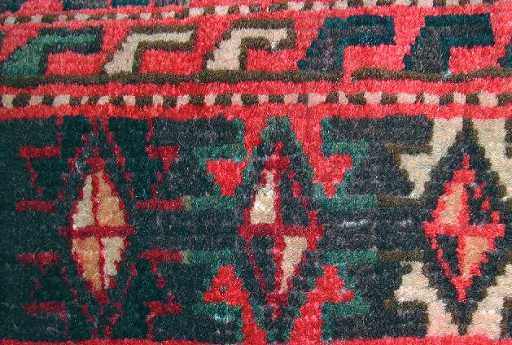Posted by Stephen Louw on 11-05-2002 12:01 PM:
Ertman Torba: Chodor or Yomut?
Hi all,
Leslie Pinner (Hali 2(4), 1980) once raised the important
question of whether torba with the ertman gul but with typically Yomut
structure (symmetrical knots and woollen wefts) were more appropriately
classified as Chodor or Yomut. She concluded that the evidence was
unpersuasive, and that we were unlikely ever to make any persuasive
attribution. More likely, she suggested, "the torbas belong to a group which
must stem from an area where, and from a period when, the opportunity was given
for the interaction of Chodor design and Yomut technique" (p.288).
I
just bought this torba -- incidently, my first "fragment" -- which, based on
its design and colour scheme, I assumed was Chodor, but on inspection is
structurally Yomut.
Perhaps someone might be able to offer, or point me
in the direction of, more recent opinion on the design/structure relationship
pertaining to ertman torba. Generally I find Pinner's (non-essentialist, common
sense) idea that different peoples lived in close proximity with each other and
shared designs convincing, but wondered if there was any alternative literature
on the specific interaction of the Yomut and Chodor peoples.

Thanks in advance
Stephen
Posted by Steve
Price on 11-05-2002 12:13 PM:
Hi Stephen,
Chodor wool is generally rougher to the touch than
Yomud wool, so this might help. I doubt that there is a definitive answer to
your question, though.
Just to muddy the water a little more: the Ersari
also used this design.
Regards,
Steve Price
Posted by
R. John Howe on 11-05-2002 04:27 PM:
Stephen -
Are you saying that the knot on this piece is
symmetric?
Steve -
Yes, the Ersari make a version of this gul but
I think not this one. Ersari ertman guls that I have seen have different
internal features in the ertman guls shown full. The Ersari usages I have seen
tend to use the version of the ertmen guls shown full in Stephen's piece only
in a half-gul position and show a different version as their full gul. There is
an example in Hans Elmby's third catalog, as Plate 48, the very last
image.

In the first of his four catalogs in Plate 23,
Elmby shows a very similar piece to Stephen's with an asymmetric knot and
unhesitatingly calls is Chodor
I think the choice is between Chodor and
Yomut.
Regards,
R. John Howe
Posted by Stephen Louw
on 11-05-2002 04:41 PM:
John
-- yes, the knots on my piece are symmetrical, much like fig. 3
in the Pinner article (I dont have the Elmby catalogues), and the wefts are
wool, not cotton
Steve
-- The Pinner article also suggested that the
Yomut wool tended to be of a different quality, as you suggest, not as rough. I
have limited first hand experience with Chodor pieces, so I wont hazzard a
guess as to how my torba shapes up.
I think, design wise, my torba is
quite different to the ersari variants I have seen.
Thanks for the
comments
Stephen
Posted by Wendel Swan on 11-06-2002 10:13
AM:
Dear Stephen and all,
Since I am unable to resolve the apparent
contradiction between structure and design that would help you pick Chodor or
Yomud, let me add to the confusion.
As is already clear from this
thread, variations of the ertman gul can be found among the weavings of several
groups. Following is an image of a battered and somewhat fragmentary chuval
face that has one version of the ertman gul. Robert Pinner refers to it as
Ersari and it has also been called Kizil Ayak, but never Chodor.

The ikat-style zigzags and the rosettes in the border are
both usually associated with work of the Ersari, but no design is ever
definitive. A few years ago, Elena Tsareva provided the metric structural
analysis and a possible attribution to the Salor; however, Salor doesn't seem
probable to me.
"Chuval bag face.
Middle Amu Darya. Salor(?) 18th
century or earlier.
Warp: wool, ivory, mixed with some brown goat hair;
Z2S.
Weft: 2 shoots; wool(?), light brown-red, Z2, and mixed brown and
white, Z1. Rather loose shooting, so that you can easily see wefts on the
back.
Pile: wool, very fine, Z2S and some Z4S (cherry-red). Knot - as open
left, slightly depressed. Knot density - 32--36(h.) x 44-48 = 1.408 - 1.728 (1
: 1,3).
Colors (10) : cherry-red, violet-red, orange-red, yellow, brown,
dark-blue, mid-blue, green-blue, turquoise, ivory.
Finish: no original
finish."
Wendel Swan
Posted by Steve Price on 11-06-2002
10:17 AM:
Hi
Wendel,
Salor?!?
Regards,
Steve
Price
Posted by Wendel_Swan on 11-06-2002 11:56 AM:
Hi Steve,
Remember that Salor was not my attribution. If I had
only seen the image on a monitor, as you have, I would also have dismissed the
Salor attribution. With the advantage of having handled the piece, I can state
that it doesn’t feel or look anything like a Salor either. What can I
say?
Elena has subsequently referred to the chuval as Ersari, but her
notes are precisely as she wrote them. I cannot explain what possessed her to
write "S-a-l-o-r."
Wendel
Posted by Marvin Amstey on
11-06-2002 04:48 PM:
Hi folks,
I have what I am convinced is a very old Kizil Ayak torba
with "perfect" Ertman guls - birds heads and all. Stephen, I would rely on
Pinner and the fact that the knot is symmetrical and call it "Yomud".
Posted by Bob Emry on 11-06-2002 11:06 PM:
Stephen et al:
In the book "Oriental Rugs, Vol.5, Turkoman, by Uwe
Jourdan (page 212, figure 179) is a picture of a torba that appears to be very
closely similar to Stephen's piece shown at the beginning of this thread--same
borders, same two-gul format, etc. Jourdan's caption says that the torba
"although very similar in design to the Chodor pair illustrated as number 228,
has wool wefts and regular symmetric knotting, a structure which indicates a
Yomut origin."
So, Stephen, you might want to check the composition of the
wefts too. If the wefts are wool, it might be further evidence of Yomut
attribution.
Cheers!
Bob Emry
Posted by R. John Howe on
11-07-2002 08:10 AM:
Stephen -
Mr. Lavergne is correct. I misread Elmby's knot
indication. He does say "chodor" and "symmetric" knot. His one sentence
commentary (page 7) in Danish does say something about about "Yomud" and
"symmetric knot" but I can't read it.
Stimulated by Bob Emry's
indication about wefts I went back and refreshed my memory of what Thompson
says about Chodor weaving.
"...All pieces have a Persian knot open to
the right, and most have a distinctive two-ply weft which is best described as
part cotton. This means that cotton is used irregularly: sometimes one strand
is plied with a strand of brown wool; sometimes both strands are cotton and
sometimes both are wool."
Stephen can we assume that your indication
that the structure of your piece is Yomut also indicates that there is no trace
of cotton in its wefts?
Regards,
R. John Howe
Posted
by Philippe_Lavergne on 11-07-2002 04:49 PM:
Chodor or Yomud?
Editor's note: I originally posted this message outside our forum,
with a link to it in this thread. I don't think many people noticed it, so I am
placing it here in toto. Steve Price
I have thought very much about
this difference: for me, the knots are important, and also the appearance of
this kind of bird in the gol.

At the first sight: nice bird + asymmetric knot = Chodor.
Nothing + symmetric knot = Yomud.
A small mistake about Elmby I plate
23 page 29:

Symmetric knot, not asymmetric
(sorry, Mr. John Howe), called Chodor without comment . This rug is also in
Hali (no. 77, p. 107) and Hoffmeister (27 p. 74), discussed as
Yomud.
The best and essential article on the subject is, "Dividing the
Chodor", by Kurt Munkacsi (Hali, no. 77, pp. 97 - 107, and appendix with a
table of structural variations.
Moshkova (fig. 113. p. 258), Chodor

Azadi, Wie Blumen in der
Wüste, (no. 87, Pseudo-Chodor; asymmetric knot)

Oriental Rug Review (XIII, no. 5, 2635 kn/dm², no
name (Ersari?)- synthetic dye

My collection: asymmetric (thus, Chodor)

My collection: good wool, very nice colours (sorry, you
just have to believe me), symmetric knots, Yomud to me:

My collection (an open bag, as you can see) I think it is
more recent: Asymmetric knots open right, and some symmetric knots on the
edges. I believe it is Yomud, not Chodor (no birds, no colors ..)

You can see another on
JBOC's Notes
on Oriental Rugs. From the Thompson collection, a chodor with an Amu-Darya
border, and technical elements.
Also on
JBOC's Notes
on Oriental Rugs, a "camel decoration".
Very confusing isn't it?
Yours,
Phil
Posted by Stephen Louw on 11-08-2002
01:52 PM:
John -- Thompson also remarks, somewhere in his auction catalogue, that
the absence of cotton wefts is a sign of a really old Chodor. This is clearly
not the case with my piece -- which has woolen wefts, and is not that old. I am
also unsure how seriously to take this claim.
Thanks all for your
comments
Stephen
Posted by Marvin Amstey on 11-09-2002 02:46
PM:
Hi Stephen,
Skepticism! I'm all in favor of that. Sometimes I think
we take ourselves too seriously in discussing these things. Good, wool ,good
color, good graphics: that's what it's all about.
Best regards.
Posted by Chuck_Wagner on 11-11-2002 05:10 AM:
Greetings All,
Here are a few images (which should have been
simpler to make than they actually were) of a piece that may make an additional
contribution to the confusion under review.
Based on what I read prior
to this discussion I had considered it a late Chodor weaving; I think I still
do, but now I'm less certain.
When looking at the white areas on the
back, there is a first impression is that the red has run. But under closer
examination these discolored knots appear to be dyed a very pale pink that has
faded to white at the tips. There is no dye in the wefts that would contribute
to a stain.
I tried rubbing the red with some alkaline water and a white
cloth, and could barely get any bleeding out of it at all, rubbing quite
briskly. So if the red ran (previously), it must have been during the initial
wash after weaving, as it appears pretty stable at this time.
But it
looks like the red is probably a synthetic, so: late 19th century.
The
whole thing:

Some detail of the drawing:

Color palette, up close (note undyed browns):

Asymmetrical open to the right, rough wool:

Structural internal details, revealed to us through a
skillfully installed area of substantial damage. Note rough wool mixed with
hair in the warps, but a fine soft light brown wool for the weft. NO cotton
visible. The wefts are clearly visible in most areas of the back:

Comments/catcalls ??
Regards,
Chuck
Posted by Steve Price on 11-11-2002 05:49 AM:
Hi Chuck,
My best guess is that your best guess is the right one.
Most likely Chodor, most likely around 1900. With the usual caveats about the
uncertainty inherent in attributions when you weren't there to see it being cut
off the loom.
Regards,
Steve Price















